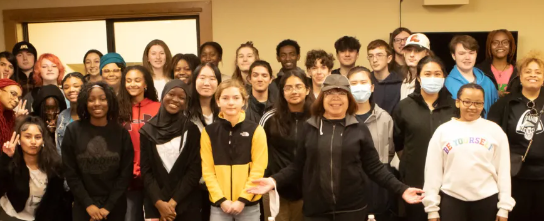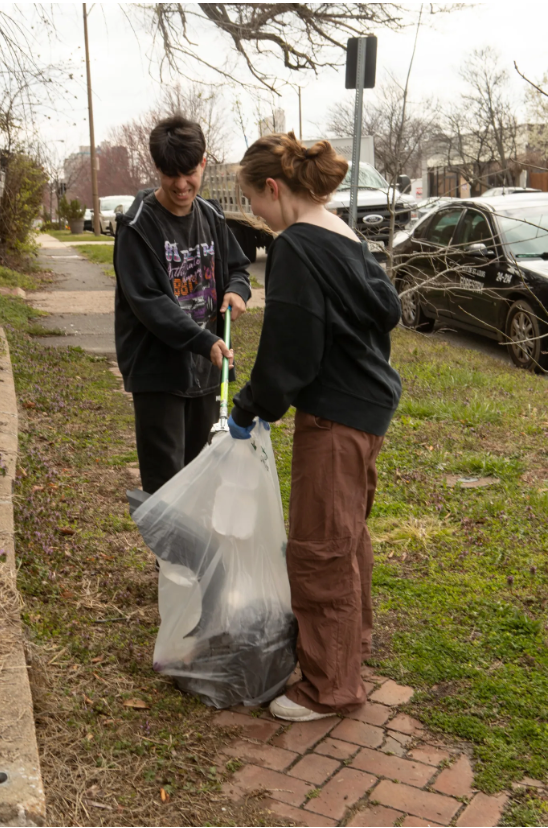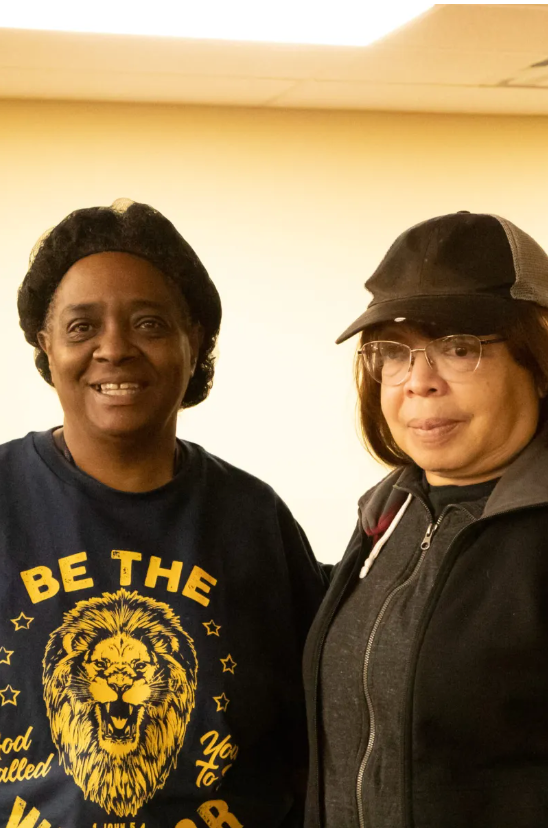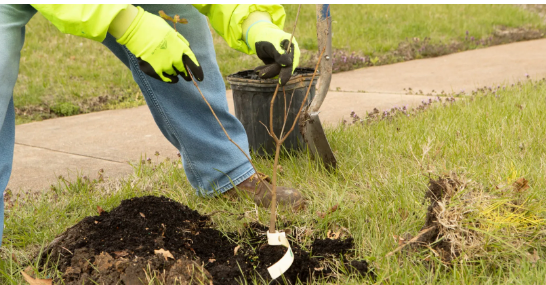BRIDGING THE DIVIDE
ST. LOUIS, MO
WE-Making is a suite of resources that explores the relationship between place-based arts practices and social cohesion as a means to advance health equity and community wellbeing. This We-Making story is one example of how place-based arts and cultural strategies uniquely contributed to social cohesion and wellbeing in this community. Throughout this story you’ll see terms paired with actions in parentheses (e.g., social capital, collective action, place attachment, civic engagement, self-determination of shared values). This is to denote for the reader how the WE-Making framework was specifically incorporated. Explore the WE-Making framework and resources.
Image credit: St. Louis Chamber of Commerce
Jim Crow laws, redlining, traffic flow projects, and the development of Mill Creek Valley among other developments in the 20th century led to the subsequent displacement of residents from the neighborhoods north of Delmar in St. Louis, especially African Americans, and destroyed individual and family relationships through the loss of shared culture and experiences. Today
St. Louis remains one of the most segregated and violent cities in the US, especially along the Delmar Divide.
To stabilize neighborhoods, safety is critical. There is the sense of safety residents St. Louis Arts Chamber of Commerce report around green spaces as well as the safety in shared cultural experiences. In response to the historical causes of the destruction of these neighborhoods, the StL Arts Chamber’s (STLACC) Art Heals Violence project focuses on bringing the arts to the policy and implementation tables to address issues such as restoring vacant lots for parks, cultural events and experiences that bind neighbors, and neighborhoods, together. With 30% of the lots in the area vacant and the documented increase in crime associated with vacant lots, the STLACC and the neighborhoods have identified 33 vacant lots, 32 of which are adjacent to the Great Rivers Greenway in the Delmar Divide. Developing these sites will link the two traditional arts areas in the city on either side of the neighborhoods and create a six-mile-long arts region.

Chicago-based artist Monty Cole has one of those voices, and he found himself drawn to Griffin’s material in complicated ways. Cole first came across a movie poster for the 1964 film adaptation featuring a tagline that read, “I changed the color of my skin. Now I know what it feels like to be Black.”
“That in itself just kind of blew me away,” he said. “I was immediately intrigued.” Upon reading the book, Cole found himself grappling with conflicting emotions. “I had an experience reading it where I was both deeply intrigued into this almost Twilight Zone story of what was happening to John Howard Griffin, but also pushing off from it, too,” he explained. “Like, ‘I don’t think that’s right. I don’t think that’s what it’s like to be a Black man.’ Or, ‘That is what it’s like to be a Black man, but how does John know that?’ Just being sucked in and pushed away. And I wanted to make a play that’s a theatrical version of that reading experience.” So, he created modern-day Black characters to reenact the story, respond in real time to the events of the play and wrestle with their own concepts of equality and social justice (creative responses to trauma and racism).
Historically, these neighborhoods have had to vie for limited resources, creating limited connection. The Violence Prevention Commission has provided grant funds for the Arts Chamber to redesign a pilot lot in the West End north of the Delmar Divide.
The Pilot Project
After several years of West End South CID efforts to create an art park at 5900 Clemens and as part of an overall plan to have an inviting greenway entrance to the West End South CID along Hamilton, the Violence Prevention Commission awarded the STLACC a $30,000 grant to implement a pilot vacant lot redesign project along with St. Louis ArtsWorks, Pocket Parks, and West End South CID.
Prior to the grant award on July 1, 2021, multiple events were held by the West End South CID for resident input into the use of the property at 5900 Clemens. The result of that extensive input was to focus on creating an art park on the site.
The St. Louis ArtWorks was awarded a $10,000 grant from the National Endowment for the Arts to create the artwork for the park. The sculptures were created by apprentices at the St LArtWorks in summer of 2021. With input from residents, ve sculptures created from bike parts included four windmills and one tree. An additional mural was designed and developed but not completed yet. The sculptures were installed in the park in September of 2021.


The Park Committee met weekly to discuss the design and installation considerations to meet the deadline for the grant, make strong visible progress for the residents and to install the park between July 1 and September 29, 2021. Six design concepts were identified for resident input. In July, two pop up events were created to identify resident choice of design for the park which was incorporated into the final design and renderings.
Once the design was determined, the survey and soil test were completed. The survey identified the property lines and several discussions were held with the neighbor directly to the west of the park. The soil test demonstrated signficant levels of lead contamination which required amelioration. To address the issue, soil for the sidewalk was removed, the land was not graded and additional soil was added to bury the contaminated soil. The existing tree was limbed up, sidewalk installed and turf seeded.
During September, two additional grants were written and awarded to the STLACC providing native perennials and trees and allowing for water runoff management to decrease mosquitos breeding areas. All of this material was installed on October 2, 2021 during a pop-up planting event where residents of all ages, races and genders came together to install their park. The sidewalk was painted with shapes and bright colors per resident input. Spring bulbs were installed on October in time for the Ribbon Cutting.
While the approximately $32,000 in grants was the basis of the project, the Park could not have been completed without the additional support of $48,000 in in-kind donations from vendors and residents. The project brought not only the residents together but also neighboring communities to connect with the park.
How the STLACC is utilizing
place-based arts and culture strategies to amplify the drivers of social cohesion
The STLACC is utilizing place-based arts and cultural strategies to amplify the drivers of social cohesion to increase equitable community well-being in four ways:
By focusing on redesign of 32 additional vacant lots that back the 3.5 mile Hodiamont Greenway linear park, we leverage the renovation of the central area by expanding the reactivation into the neighborhoods themselves. Each resident provides input into the greenspaces in
their neighborhoods (self-determination of shared values- neighbors of different backgrounds can recognize that they may share similar goals). As in the pilot project noted above, residents come together when they see real change. As a benet, the Project addresses issues of storm water runoff, mosquito breeding, crime on the lots and increased property values for homeowners.
As a corollary, the Greenway through the underserved area literally links the Grand Center Arts District on the east end of the Greenway to the Delmar Loop District on the west end of the Greenway creating a safe area for everyone from symphony goers in Grand Center, aficionados of jazz and blues which sprang from the African American area we are working in to the rock and roll centers of the Delmar Loop. Expanding upon the regional redesign of the larger greenway, the Project expands the footprint of the Greenway strengthening the communities adjacent to the greenway through community collaboration on a resident identified priority (place attachment- mutually reinforcing social capital (bridging)). Economic change created by artistic professional development through interaction with community resources is critical for the area. Resident driven art parks and events in them bring audiences from around the area to support local businesses and change the negative image of the area. The Project achieves physical change in the neglected areas by establishing local venues where artists can perform/exhibit while creating safe gathering places for residents (place attachment- creating rewarding experiences within community places). These events will provide an important source of social change by increasing meaning and revenue for the region. By including the residents at each stage from the input to the enjoyment of the art, new connections and trust are formed between them (city organizations and others from outside the neighborhood) and us (resident artists and leaders).

As with the pilot, a key aspect of the Project is reaching out to the community to actually design and install the park and artwork. Call for artists living in the area, contractors and others needed to create, install the project come as much as possible from the neighborhoods themselves creating economic opportunity and capacity building for those businesses.
Expanding from the pilot lot, the STLACC has partnered with the public-school system to create a mentorship/internship program for high school seniors to participate in any of the skills needed to actually create the park and social change (civic engagement- initiating a desire for more hyper-local civic engagement, especially impacted youth). They can explore interview and storytelling skills to obtain resident input; participate in the design, address the legal, financial and policy implications of the project; work with the contractor or any of the subs, learn landscape design and maintenance and so much more that strengthen skills needed in the job market while actually positively affecting
their community.
The pilot and now the expanded Project have created collaborations around the arts and design ranging from individual residents to neighborhood and city leaders to state and federal opportunities. This is a key collaboration to continue to expand the concept throughout the underserved area of St. Louis. Residents in the pilot area have already reached out to our collaborators to expand on the park.



